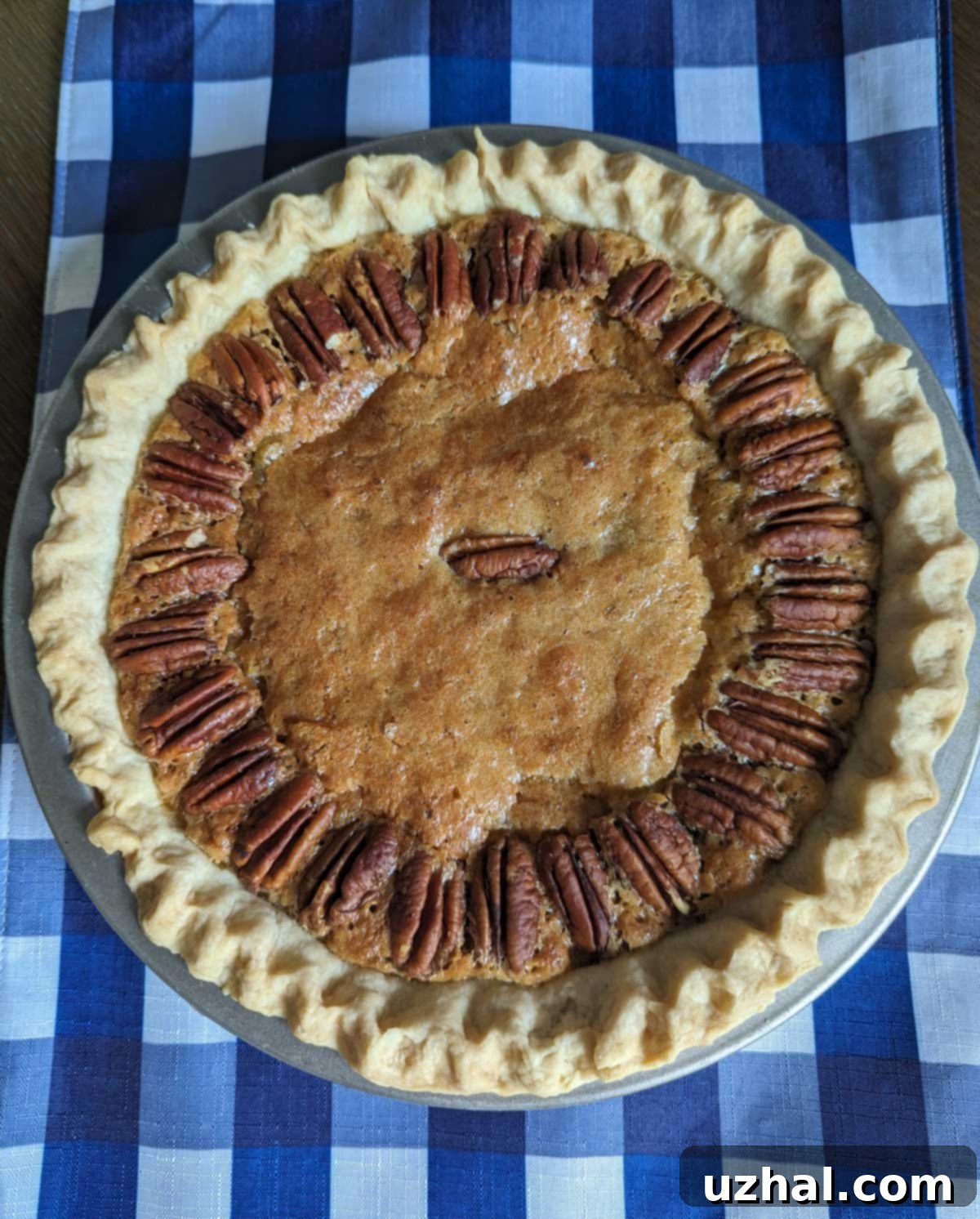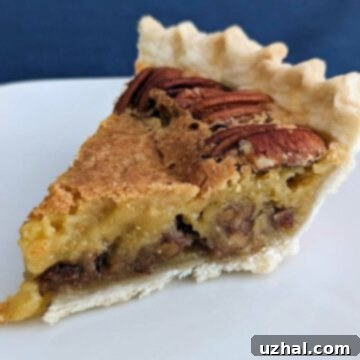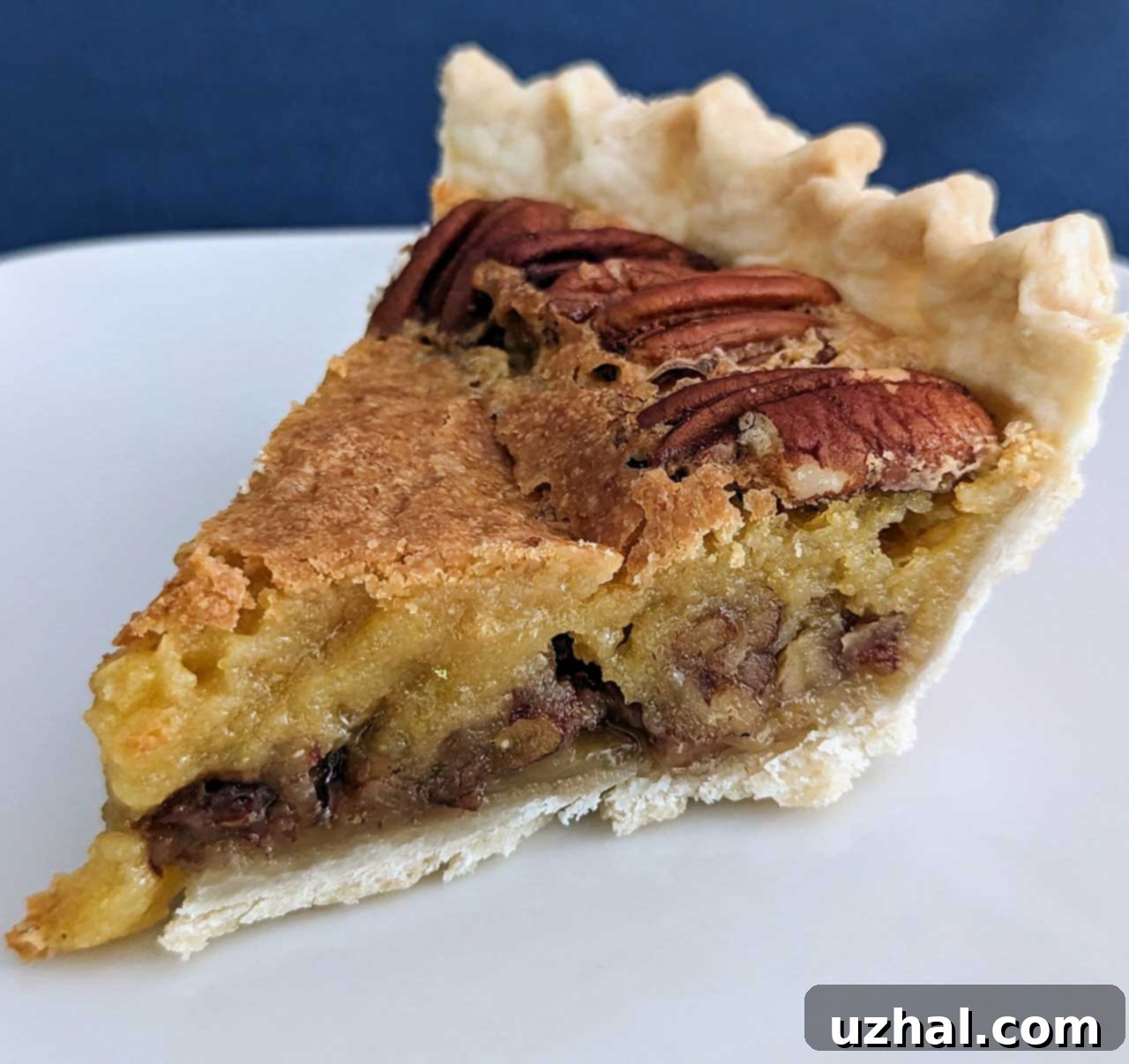Discover the Unique Tang of Vinegar Pecan Pie: A No-Corn Syrup Southern Delicacy
Pecan pie is a quintessential Southern dessert, beloved for its rich, sweet, and nutty profile. But what if you could elevate this classic with a surprising twist, creating a pie that’s equally decadent yet refreshingly balanced? Enter Vinegar Pecan Pie. This unique recipe stands out from traditional versions primarily due to two intriguing ingredients in its filling: a tablespoon of vinegar and a tablespoon of cornmeal. Moreover, it proudly boasts a no-corn syrup formula, relying instead on the harmonious blend of granulated and brown sugars for its delightful sweetness. This innovative approach yields a pie that is not only delicious but also offers a more complex flavor dimension and an intriguing texture profile, making it a memorable addition to any dessert table.
Jump to Recipe

The Secret Ingredient: Why Vinegar Belongs in Your Pecan Pie
The idea of adding vinegar to a sweet dessert like pecan pie might initially sound unconventional, even strange, but it’s a culinary trick that makes a remarkable difference. A small amount of vinegar serves multiple critical functions that significantly improve the pie’s overall quality. First and foremost, vinegar introduces a subtle acidic note that masterfully cuts through the inherent richness and sweetness of the pie. Pecan pies, especially those relying on generous amounts of sugar, can sometimes be overwhelmingly sweet. The vinegar acts as a counterpoint, brightening the flavor profile and preventing the pie from tasting cloying. Think of it as a squeeze of lemon on a rich dish – it balances and enhances without dominating.
Beyond flavor balance, vinegar plays a crucial role in the texture of the filling. In desserts where sugar is a primary component, crystallization can sometimes occur, leading to a grainy or less smooth texture. The acid in vinegar helps to curb this crystallization, ensuring the filling remains wonderfully smooth and velvety. This effect is particularly beneficial in a no-corn syrup pecan pie, as corn syrup itself often helps to prevent sugar crystallization. Without it, vinegar becomes an even more valuable ally in achieving that perfectly smooth, melt-in-your-mouth consistency that defines an excellent pecan pie. Whether you choose white vinegar, apple cider vinegar, or malt vinegar, each offers a slightly different, nuanced “kick of acid” that makes the pie truly special, even if the specific vinegar flavor isn’t overtly detectable.
Choosing the Best Pecans for Your Pie
The star of any pecan pie is, of course, the pecans themselves. As someone with a soft spot for Texas pecans—considering the pecan is the state tree and I grew up surrounded by them—I understand the regional pride associated with this nut. However, pecans are cultivated across various Southern states and even in Mexico, with flavors varying significantly based on the type and growing conditions. For this Vinegar Pecan Pie, I’ve had great success with Kirkland (Costco) pecans, which have been exceptionally good in recent harvests. A 2022 article from The Costco Connection noted that these particular pecans are sourced from Mexico, attesting to their high quality.
Regardless of their origin, the key is to use fresh, high-quality pecan halves. Look for plump, uniformly colored nuts without any shriveling or rancid smell. It’s often a good idea to purchase a slightly larger bag than the recipe calls for, as this allows you to hand-pick approximately 20 to 30 of the most beautiful, unbroken halves to arrange decoratively around the pie’s border. These carefully selected halves will not only add to the visual appeal but also provide a satisfying textural contrast. The remaining pecans, typically about a cup and a half, will be lightly toasted and chopped to form the rich, nutty base of the filling, infusing every bite with their distinctive flavor.
The Magic of Two Distinct Layers: A Textural Delight
One of the most captivating features of this Vinegar Pecan Pie, akin to the fascinating transformations seen in Magic Cake or Vienna Pie, is its tendency to separate into two beautiful, distinct layers during the baking process. This “magic” results from the different densities of the ingredients in the filling, which naturally stratify under the heat of the oven. Once fully baked and cooled, each slice will reveal a dark, intensely nutty layer at the bottom, packed with the flavorful toasted pecans. This bottom layer offers a rich, almost caramelized depth of flavor.
Crowning this nutty foundation is a buttery, wonderfully smooth layer on top. This creamy, custard-like upper layer is where the vinegar truly shines, contributing to its silky texture and balanced sweetness. Additionally, you’ll notice a subtle textural contribution from the cornmeal, unless, of course, it was accidentally omitted. During testing, we found the pie is still enjoyable without the cornmeal, but its inclusion adds an extra dimension of texture and a delicate, earthy flavor that complements the pecans perfectly. These two distinct layers provide a delightful contrast in both texture and taste, transforming a simple slice of pie into a multi-sensory experience.
Achieving Perfection: The Internal Temperature of Pecan Pie
Knowing when a pecan pie is perfectly done can be tricky, as it often looks set on the edges but can still be too jiggly in the center. The most reliable method to ensure a perfectly baked pecan pie is to use an instant-read thermometer. Generally, pecan pie is considered done when its internal temperature reaches 200 degrees F (approximately 93 degrees C). While slight variations might exist between recipes, aiming for a top-out temperature of 200F is an excellent guideline for determining the ideal pull time from the oven. At this temperature, the pie’s center should still exhibit a slight, delicate “jiggle” when gently shaken. This subtle movement indicates that the custard has set just enough but remains wonderfully creamy and tender, rather than becoming stiff or rubbery.
Despite the reliability of a thermometer, it’s surprisingly easy to forget to take the temperature in the heat of the moment! In my own tests, I’ve often relied on visual cues and timing. A 50-minute bake time, for instance, has consistently yielded excellent results for this particular recipe, with 50 minutes being on the higher side. However, for consistent perfection, especially if you’re new to baking pecan pies, I highly recommend using a thermometer. It removes the guesswork and helps ensure your pie is always baked to its ideal consistency, preventing both under-baked runny centers and over-baked dry fillings.
Enhancing Flavor and Texture: Freezing and Thawing Your Vinegar Pecan Pie
It might come as a surprise, but this Vinegar Pecan Pie, much like many other pecan pies, often improves significantly after undergoing a freezing and thawing process. The act of freezing and then gradually thawing seems to have a magical effect on the pie’s texture, particularly benefiting those that might have been slightly over-baked. If you find yourself with a pecan pie that’s a bit firmer than intended, don’t despair! Simply wrapping it tightly in plastic wrap and then aluminum foil, and popping it into the freezer overnight, can work wonders.
While I can’t guarantee it will salvage every single over-baked pie, the freezing process frequently smooths out the middle, resulting in a more luscious and less dense filling. Furthermore, it often enhances the definition between the pie’s two distinct layers, making them even more pronounced and enjoyable. Even if you only have a few hours to spare for freezing, you’ll likely notice some improvement. When you’re ready to serve, remember to bring the pie back to room temperature. This allows the flavors to fully bloom and the texture to return to its optimal state, ensuring every bite is as delicious as possible.
Frequently Asked Questions About Pecan Pie
Beyond the specific details of this unique Vinegar Pecan Pie, many common questions arise when baking this Southern favorite. Here are some frequently asked questions and their answers to help you achieve pecan pie perfection:
While some pecan pie recipes do recommend par-baking the crust, it’s not a step I typically incorporate. If you are using a very thick homemade pastry crust, or if you’ve struggled with soggy bottoms in the past, a brief par-bake (baking the empty crust partially before filling) could be beneficial. However, for most standard crusts, you can generally pour the filling directly into an unbaked crust. A helpful tip to ensure a thoroughly baked bottom crust is to bake the pie on a preheated baking sheet. Placing the pie dish on a hot sheet pan helps transfer heat more efficiently to the bottom of the crust, promoting even baking.
Absolutely, toasting your pecans can significantly enhance the flavor of your pie! When pecans are toasted, their natural oils are released, intensifying their nutty aroma and deepening their flavor through the Maillard reaction. This is particularly important for the pecans that are incorporated directly into the filling, as their toasted essence will permeate every bite. For the pecans used decoratively on the border of the pie, toasting prior to baking isn’t strictly necessary, as they will naturally gain some toastiness and deepen in color during the pie’s bake time.
Yes, brown butter is an excellent addition to pecan pie and can truly elevate its flavor! Browning butter means gently cooking it until the milk solids caramelize, developing a rich, nutty aroma and a complex, slightly toasted flavor that pairs exceptionally well with pecans. In this specific Vinegar Pecan Pie recipe, browning the butter is optional, as the recipe is designed to be delicious with simply melted butter. However, if you’re exploring other pecan pie recipes or wish to add an extra layer of depth to this one, browning the butter beforehand is a fantastic way to enhance the overall flavor profile.
It’s true, I have quite a few beloved pecan pie recipes, each with its own charm! For those seeking a consistently excellent and reliable outcome, I usually recommend Mom’s Pecan Pie; it’s a tried-and-true classic that rarely disappoints. The pie I find myself making most often, or have made the most over the years, is the One Stick of Butter Pecan Pie. While it can be a bit more delicate in consistency and sometimes runs a little, its flavor is absolutely incredible! For a wonderful compromise that combines the best of both worlds, offering a rich flavor with a more stable set, try Best Pecan Pie Yet, which features a reduced amount of browned butter and a touch of cream for added richness.
Now that you’re well-versed in the unique qualities and baking nuances of this special dessert, it’s time to dive into the Vinegar Pecan Pie recipe! This particular version is a tried-and-true adaptation inspired by a fantastic recipe found on Discover South Carolina. I’ve personally made it twice, and my colleague Fuzz has also successfully baked it once. Even when Fuzz accidentally omitted the cornmeal from the pecan pie, it still turned out wonderfully delicious, proving its inherent robustness and adaptability. Get ready to experience a Southern classic with an unforgettable, tangy twist!
- Thick Fudge Brownies Made In One Saucepan
- Banana Bread with Sour Cream and Oil
- Chocolate Syrup Swirl Cake with Ganache Glaze
- Good Pie Crust Recipe
- Six Inch Red Velvet Cake
Recipe

Vinegar Pecan Pie
Anna
Pin Recipe
Ingredients
- 1 9-inch unbaked pastry crust (preferably not a deep dish for best layer separation)
- 2 cups pecan halves (start with a big bag to select the best for border)
- 3 large eggs (at room temperature for better emulsification)
- ¾ cup granulated sugar (150 grams)
- ¾ cup brown sugar (150 grams, packed)
- 2 teaspoons vanilla extract
- ½ cup melted butter (gently melted and cooled; salted or unsalted works)
- ⅛ to ¼ teaspoon salt (use ⅛ tsp if butter is salted, ¼ tsp if unsalted)
- 1 tablespoon fine cornmeal
- 1 tablespoon vinegar (white, apple cider, or malt vinegar)
Instructions
-
Preheat your oven to 350 degrees F (175 degrees C). Place a rimmed baking sheet in the oven while it preheats; this helps ensure the bottom crust bakes evenly.
-
Carefully select and set aside about 25 to 30 of the nicest pecan halves (approximately a heaping half cup) to be used for the decorative border of the pie. Spread the remaining pecans (about a cup and a half) in a single layer on a separate baking sheet. Toast them in the preheated oven for about 6 to 8 minutes, or until they become fragrant and begin to release their oils. Remove from the oven, let them cool slightly, then chop them coarsely.
-
Evenly spread the chopped, toasted pecans across the bottom of your unbaked pastry crust in the pie dish.
-
In a large bowl, whisk the eggs thoroughly until the yolks and whites are fully blended and slightly frothy. Then, whisk in the granulated sugar, brown sugar, vanilla extract, gently melted and cooled butter, salt, cornmeal, and vinegar until the mixture is smooth and well combined.
-
Carefully pour the prepared filling over the chopped pecans in the pie crust. Artfully arrange the reserved whole pecan halves around the side of the pie, creating an appealing border.
-
Carefully place the pie onto the preheated rimmed baking sheet in the oven. Bake for 45 to 50 minutes. The pie is done when the edges are set and lightly golden, but the center should still have a slight, delicate jiggle when gently nudged (internal temperature should reach 200 degrees F).
-
Remove the pie from the oven and let it cool completely on a wire rack for several hours until it reaches room temperature and the filling is fully set. For an enhanced texture and flavor, cover the cooled pie tightly and freeze it overnight, if time allows. Always bring the pie back to room temperature before slicing and serving for the best experience.
Notes
